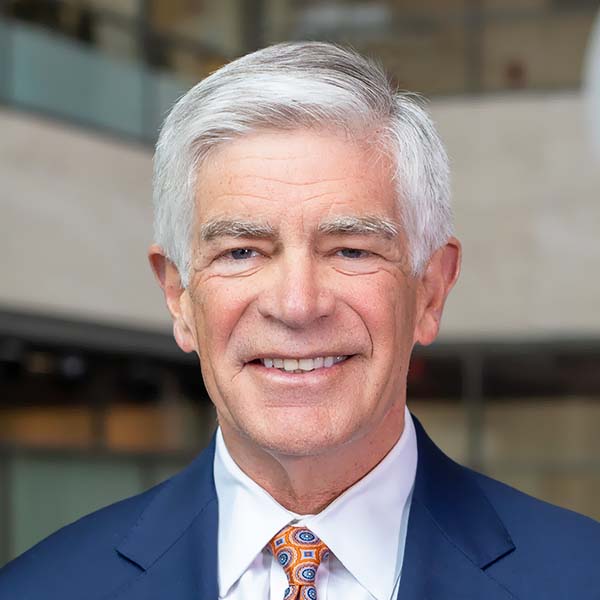Thank you, it’s a pleasure to be here, particularly in such good company. People start paying a lot less attention to Fed presidents when we roll off our voting positions, so maybe some of the limelight from my esteemed fellow panelists will fall on me.
I’ve been asked today to share my views on the U.S. economic outlook and the appropriate stance for monetary policy over the near term. That part about “my views” is an excellent segue to the standard Fed disclaimer that I’m sure you’ve already heard enough times to know by heart: The views I express today are mine alone and do not necessarily reflect those of anyone else in the Federal Reserve System.
John Kenneth Galbraith takes the honor of probably the most quoted — and some might say the most accurate — line about economic forecasting, which is that it exists to make astrology look respectable.
Jokes aside, we’re in a time and place in the arc of economic history — both domestically and globally — that renders prediction slightly more difficult. I’m a firm believer in the Fed’s mantra of being data driven, and 2018 is, for me, a year to be in monitoring mode.
So, rather than go into a lengthy disquisition, and, in the spirit of the new year’s call to be more perfect people, I’m going to keep to my time today and just give a brief overview of where I think we’re heading and what I’ll be watching.
I see growth of a little under 2½ percent for the year.
I see a labor market with very little slack left. I expect the unemployment rate to stay low before ticking back up a few tenths of a percentage point sometime after this year.
Job creation will slow and should dip to around 100,000 a month by the end of 2019, but that’s to be expected, and it’s more than enough to keep pace with population growth.
Inflation continues to run below target, not just in the U.S. but in countries across the globe. Domestically, I expect inflation will run a bit above target in 2019 and come down to target the following year, but I am more hesitant in this view than I am on economic activity. If soft inflation persists, it may pose a significant problem, which I’ll get to shortly.
For that reason, my own view is that two rate increases are likely to be appropriate for 2018.
Of course, I’ll continue to monitor the data as they roll in, but that’s the view as we start out the new year.
Aside from inflation having stayed persistently under target for longer than we forecast, there is a lot to watch generally, and much of it, in some form or another, is new territory. The phrase the “new normal” has become so common that it’s almost cliché, but that doesn’t mean it’s not an accurate assessment of the current situation. I don’t see any of it as particularly disruptive, but it’s new nonetheless.
We are unwinding the largest balance sheet in Fed history, and, largely because of the infusion of MBS during QE, it also looks different than it did before the recession. This normalization has, and will continue to be, one of the most boring functions of monetary policy — and aside from those of us gathered here today, not a lot of people consider monetary policy a barn burner of a subject in the first place. It will unwind mechanically in the background and, because it has been so well communicated, should have minimal effects going forward. Still, it’s new territory.
I’m also keeping an eye on the yield curve. I think worries so far have been a little inflated, and I don’t think the situation we’re in now is analogous to the inversion associated with the stagflation of the ’70s and ’80s. It does bear some resemblance to the flattening in the mid-2000s. Overall, I’m keeping the same watchful eye that I am on a lot of other developments, but I think the removal of accommodation will help somewhat, and I don’t think it warrants shouting “fire” in a crowded theater.
The most important issue on the table right now is that we need to consider the possibility of a new economic normal that forces us to reevaluate our targets. There has been a lot of research lately, including by my colleagues at the Board of Governors and other Reserve Banks, suggesting that we may just be in a low r* (r-star) environment right now.
Market interest rates have been trending downward for years, starting long before the recession and appearing to have continued through the crisis and the current expansion. That obviously pulls us closer to the zero lower bound and leaves us with less policy ammunition in an unexpected turn of events or, worse, a full-blown crisis. We can only play the hand we’re dealt, and fed funds can only operate within the scope that the natural funds rate allows.
The conundrum of central banking, and the Fed in particular, is that while monetary policy is an important tool, it’s a blunt one and is limited by the environment in which it’s conducted. When people talk about the Fed being the most important body in the economy, I have to laugh a little; it’s important, absolutely. But we are a single factor in a massive machine with multiple moving parts.
So, if it is the case that we’re in a low r* environment and one that is likely to last for a decent amount of time, will we have to start discussing other options? In such an environment, and with a symmetric loss function, it may be difficult to meet our inflation objective. Relatively frequent occurrences of zero lower bound constraints may imply that inflation will, on average, run below 2 percent rather than above it. In that scenario, inflation expectations could trend down, making it even more difficult to meet our target. It may, therefore, be time to reevaluate the way we conduct policy. I should be clear that I’m not pushing for any changes, nor do I have any particular change I would prefer.
But it is a question for the profession itself, and we do need people thinking about this. I’d add that if and when that discussion arises, we need to be seriously considering the various alternatives — whether it’s inflation targeting, price-level targeting, or asymmetric loss functions — and not fixating on one without serious academic debate about the others.
The last thing I’d add is that of the various lessons of the past decade, the importance of communication will apply here. One of the key lessons of the taper tantrum, which was confirmed by the announcement that we’d be normalizing the balance sheet, is that the way we signal our intention to the markets and public is essential. I wasn’t a Fed president in 2013, but I was on the board of directors at the Philadelphia Fed, and we were surprised by the market’s reaction. Consequently, we took pains to communicate early and often — we did everything short of putting it in skywriting — that we were planning to start unwinding. When we did, the markets shrugged.
This is important because, as a colleague of mine points out, something like an asymmetric loss function is easy to explain in an economic research paper; it’s harder to communicate to markets and the public. Whatever steps we may ultimately take in the future, communication has to be part of it.
In keeping with my promise, I’m going to end it there. I think the areas to watch, discuss, research, and evaluate are a relatively short list in and of themselves. The conversations, however, are myriad.
Note: The views expressed are my own and not necessarily those of the Federal Reserve System or the FOMC.
View the Full Speech
